 Kelly Blewett visiting the Harriet Beecher Stowe House Kelly Blewett visiting the Harriet Beecher Stowe House Kelly Blewett is an assistant professor of English at Indiana University East, where she also directs the writing program. She joined the Board in January 2021. Following are edited excerpts from an interview with Dr. Blewett. When did you first learn about the Harriet Beecher Stowe House? I first learned about the House when I did a service project through my church in 2012. Our assignment was doing work at the House. I later researched the House more in 2014 when I was working on a project at the University of Cincinnati. What is one piece of advice you would give someone who is interested in becoming a volunteer, member, or even a board member? Go ahead and jump right in! I thought about getting involved with the Friends of Harriet Beecher Stowe House for a long time. In 2020 I decided to reach out and see if there were any openings on the Board. I was interviewed by Kathryn and Christina and started my position on the Board in January 2021. It has been a pleasure working with this community. I love to see people invest in their local communities and give their time and talent to organizations that they believe in. Kelly aims to use the same ideas that are taught at the Harriet Beecher Stowe House in her classroom by being attentive to equity and inclusion issues. A former book publicist, Kelly is a voracious reader and spoke of the book, The Black Friend by Frederick Joseph. The Black Friend offers up personal stories of Fred and other activists to teach White audiences about racism.
0 Comments
CINCINNATI — Perhaps one of the most amazing pieces of hidden Cincinnati lies just up the road from WCPO’s station in Walnut Hills. It’s a place you have probably passed hundreds of times but never visited, and one that once housed the author of one of the greatest catalysts for the end of slavery in America.
Continue reading at WCPO.com. We know Cincinnati has been a popular place to make films – but what about books? This may not be New York, but there are enough novels set in Cincinnati to grab our attention. Some authors are local, some not. Some wrote about historical events, or changed the city’s name – but we know it’s really the Queen City. There are mysteries and romance and urban fantasy. Award winners and popular page-turners. There’s something for every reader. Here are a few Cincinnati novels you might want to add to your reading list. Read the rest of the article at the Cincinnati Enquirer here.
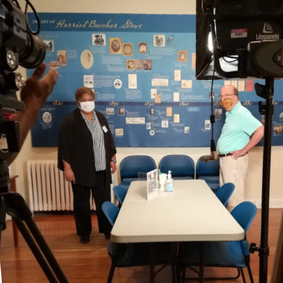 Gina Ruffin Moore sharing about the importance of history in the "old kitchen" of the Harriet Beecher Stowe House (Sept. 2020) Gina Ruffin Moore sharing about the importance of history in the "old kitchen" of the Harriet Beecher Stowe House (Sept. 2020) Board member Gina Ruffin Moore moved to Cincinnati as a teen. She serves as the Secretary of the Board of Friends of Harriet Beecher Stowe House. Gina is the author of a book on the history of African Americans in Cincinnati, Cincinnati: The Black America Series. Her book is published by Arcadia Publishing and can be found for sale in the bookstore. Following are edited excerpts from an interview with Ms. Ruffin Moore. When did you first learn about the Harriet Beecher Stowe House? I first learned about the Harriet Beecher Stowe House when I was 13 or 14 years old. I lived in Walnut Hills and my dad took us on drives to see historic spots. We used to drive past it many times. What is your favorite event? I really enjoyed the Do the Right Thing film discussion (February 2021 Semi-Colon Club). I saw the Spike Lee film when it first came out. I enjoyed hearing other people’s perspectives on the film. I also enjoyed an event before COVID-19 when we watched a video on the history of the Black Panther Movement and then had a discussion. What is one thing you have learned since becoming actively involved with the Harriet Beecher Stowe House? I have learned much about the Lane Seminary Debates that happened in 1834. The professors at the Lane Seminary were not very keen on the students debating on the topics of colonization vs. immediate freedom. The differences between the professors and the students led to the fall of Lane Seminary and many students transferring to Oberlin College. The leadership at Lane Seminary was not very progressive at that time. Gina recommends people interested in volunteering to read Uncle Tom's Cabin and to learn about Josiah Henson. Check out our bookstore for both of these books. The Friends of Harriet Beecher Stowe House is pleased to welcome several new members to the Board and staff team in 2021. Read below to learn what led each of them to get involved in extending Harriet Beecher Stowe's legacy in Cincinnati and beyond. New to the Board: Kelly Blewett is an assistant professor of English at Indiana University East, where she also directs the writing program. She thinks more Cincinnatians should read Uncle Tom's Cabin, a book she did not encounter until graduate school, even though she grew up in Cincinnati. As part of the board at Stowe House, Kelly looks forward to making connections with other community organizations and helping to shape programming that will further the mission of the Stowe House and contribute to Cincinnati's book culture. Prince Edward Johnson, II is a Cincinnati native from Evanston and a doctoral candidate at Miami University's Education and Leadership Program. He has done community organizing working through education abroad and locally. He hopes to center discussions on restorative justice and anti racism through Cincinnati's historical traditions of abolitionism in the city. Cheli Reutter is associate professor of English at the University of Cincinnati, with specializations in the 19th century, race in American literature and in the medical humanities. She got involved so that she could expose students to Stowe's legacy, and so she could engage with community members in these literary and historical issues of Stowe's times and ours. More than 100 years since Stowe's death, the same broad topics and themes she and her family addressed, like race and gender equity, continue to call for our attention here in Cincinnati. Cheli wants to highlight the Stowe House's public history projects, the Semicolon Book Club, lecture series and individual events, and hopes to support additional outreach, for example to the UC community and other college communities. New to the staff team:
Mary Casey-Sturk (Administrative and Development Associate) has been in the non-profit sector since 2002, much of that time working in a museum environment, and as a fundraiser since 2008. She says, "My passions are museums, social justice, and writing-in fact I have been writing professionally since 2007. When I first became involved with the Harriet Beecher Stowe House it was because I was drawn to her story, to the stories of those who lived within the walls, and to the challenges we still face. What I most admire about Harriet is that she wrote for a living, to put food on the table and support her family, it’s that part of her story that most fascinates me, and I hope I can share this with many others." Michele Bricking (Scripps-Howard Communications Intern) is a senior at Northern Kentucky University studying marketing and history. She says, "Last semester, I took a class on the Underground Railroad which instilled in me a deep interest for Black History and activism. I was fortunate to find out about the Harriet Beecher Stowe House in November when searching for internships. I was hired on to the team as a marketing intern and am enjoying learning more about Harriet Beecher Stowe, abolitionists, women's rights activists, and much more." The Harriet Beecher Stowe House continues to undergo restoration efforts as the new year progresses. Additions and renovations had been completed on the house through the ownership of the Montfort family and later a boardinghouse and tavern. Through this restoration, the house will be more similar to when the Beecher family resided there. This will allow visitors to connect with the Beecher family and experience how the home looked when they were residents in the 1830s and 1840s. However, the connections with future homeowners will remain as they will be discussed on tours and one room will remain a replica of a room in the boardinghouse. Through paint analysis testing conducted by experts, the brick was discovered to have been yellow in the 1840s. These 188-year old bricks have up to 17 layers of paint that are being removed. Once the paint is removed, the bricks will be evaluated. The additional brick from future years will be replaced with replica to create a consistent appearance on the exterior of the house. Once the brick is completely stripped of paint and replica is inserted, the exterior will be painted a pale yellow to match the paint analysis discovery.  January 21, 2021 January 21, 2021 Chris Buchanan, Ohio History Connection’s Restoration Specialist, uses his skills and experience to explain the restoration process of the Harriet Beecher Stowe House. The mason work on the house is unique in certain places. The back and sides of the house consist of struck joints in which the mortar used in spaces between the bricks is sloped inward to be flush with the surface. This is a common practice for mason work. The front of the house was created using ruled joints which gave the brick a refined and handmade look to it. On December 15th, the 1908 bay windows were removed. When the Beecher family were residents of the home there was brick wall and smaller windows in place of the bay windows. Through expert observation, it was determined that the original windows were located to the left of the center of the room close to the old kitchen. Smaller windows to better match the appearance of the Beecher home will replace this area on the north side of the house. To see videos of the restoration process, click below.
www.youtube.com/playlist?list=PLnlusQRbjQuE5x8o00fsbDRC_lJr_sVks |
Archives
March 2025
Categories
All
|
|

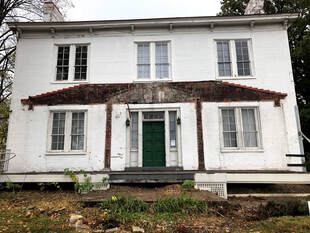
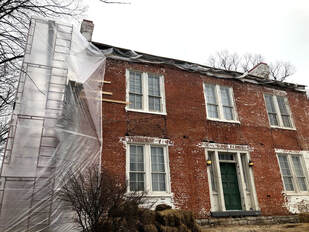
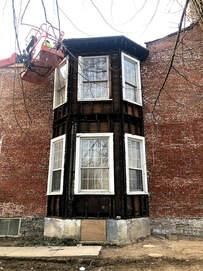
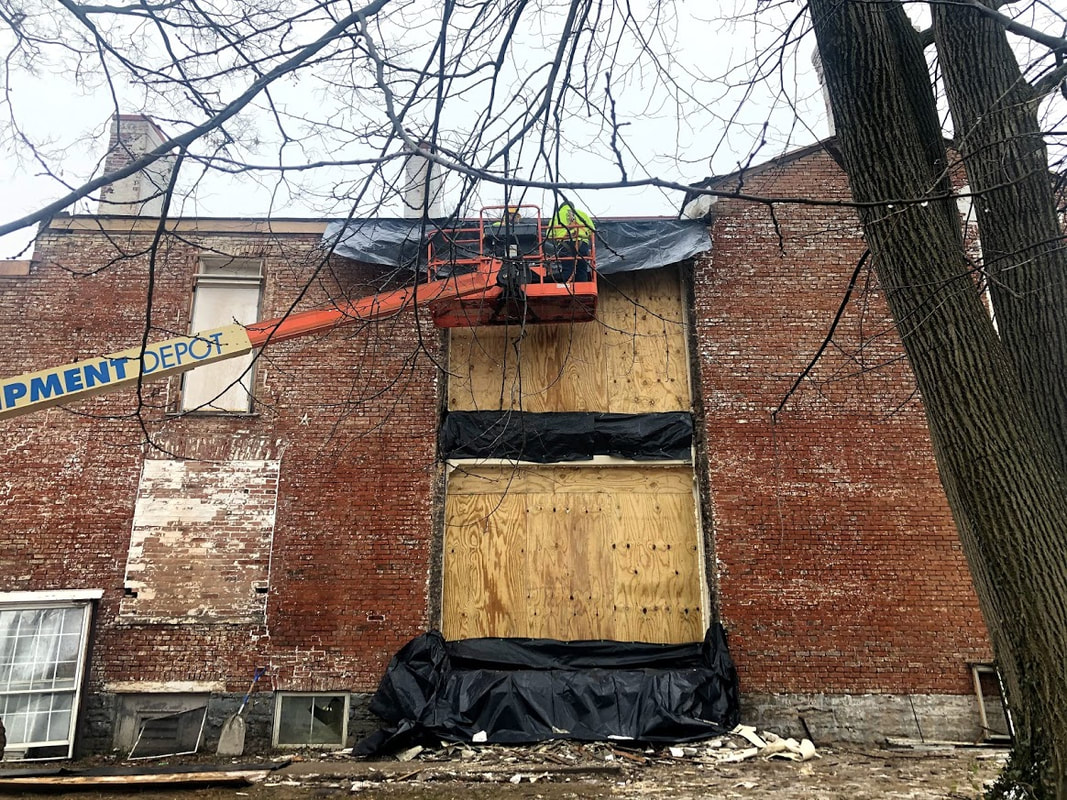
 RSS Feed
RSS Feed